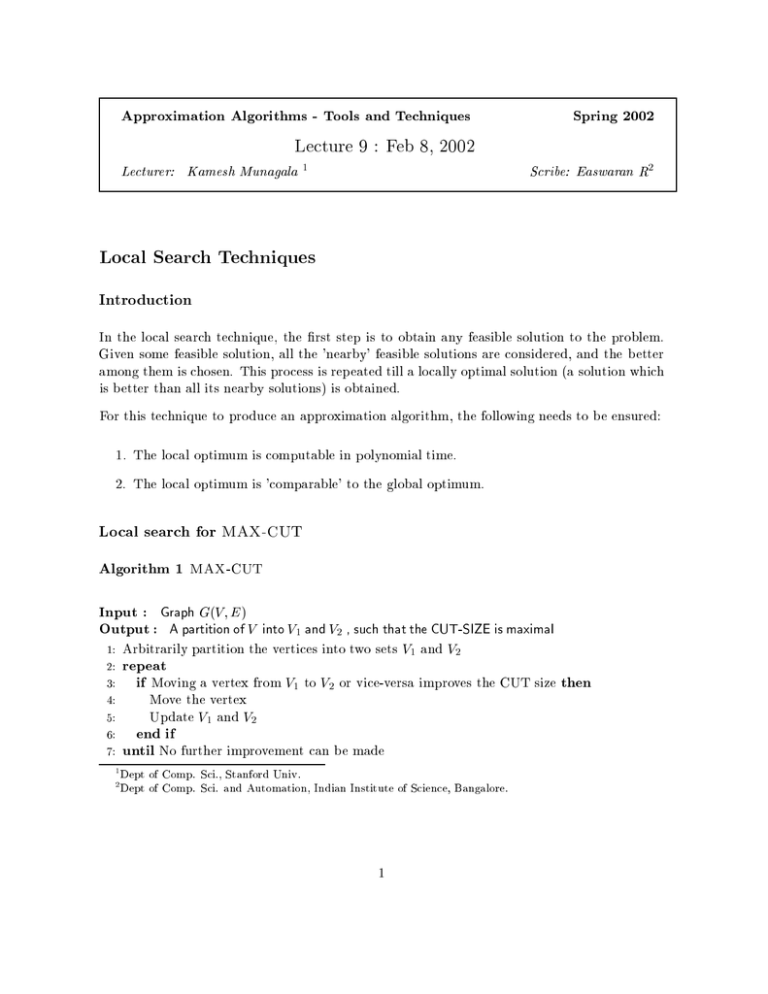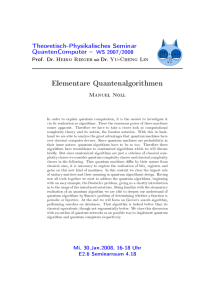дс п к ж л р уы ×
реклама

Approximation Algorithms - Tools and Tehniques Leture 9 : Feb 8, 2002 Leturer: Kamesh Munagala 1 Spring 2002 Sribe: Easwaran R2 Loal Searh Tehniques Introdution In the loal searh tehnique, the rst step is to obtain any feasible solution to the problem. Given some feasible solution, all the 'nearby' feasible solutions are onsidered, and the better among them is hosen. This proess is repeated till a loally optimal solution (a solution whih is better than all its nearby solutions) is obtained. For this tehnique to produe an approximation algorithm, the following needs to be ensured: 1. The loal optimum is omputable in polynomial time. 2. The loal optimum is 'omparable' to the global optimum. Loal searh for MAX-CUT Algorithm 1 MAX-CUT Input : Graph G(V; E ) Output : A partition of V 1: 2: 3: 4: 5: 6: 7: 1 2 into V1 and V2 , suh that the CUT-SIZE is maximal Arbitrarily partition the verties into two sets V1 and V2 or vie-versa improves the CUT size then Move the vertex Update V1 and V2 end if until No further improvement an be made repeat if Moving a vertex from V1 to V2 Dept of Comp. Si., Stanford Univ. Dept of Comp. Si. and Automation, Indian Institute of Siene, Bangalore. 1 2 LOCAL SEARCH TECHNIQUES The running time of the above algorithm is O(jV j jE j). The proof of the following theorem is left as an exerise. Theorem 1 The LOCAL-SEARCH for MAX-CUTprodues a 0:5 approximation Minimum degree spanning tree Denition 1 The Minimum degree spanning tree (MDST) for a graph ( G V; E tree suh that the maximum degree of any vertex in the tree is minimized. ) is a spanning Let the degree of the optimal solution = Deiding whether = 2 is NP hard as this problem is reduible to nding a Hamiltonian Path in the graph. The following theorem states that a polynomial time approximation exists for the problem. Theorem 2 There exists a polynomial time algorithm that nds a tree of degree +1 In this leture, we will be showing a log n approximation for this problem. An algorithm to get 2 + log n degree spanning tree Theorem 3 If removing W verties disonnets a graph into T onneted omponents, then W +WT 1 Removing the W verties results in T omponents (Figure 1). For the W verties to be onneted, a minimum of W 1 edges are needed, and sine the T omponents have to be onneted, another T edges are needed. Hene a total of W + T 1 edges are needed. These edges are to be inident on the W verties. Hene, there is atleast a vertex among the W verties with degree W +WT 1 in any spanning tree. The idea behind the loal searh tehnique for Minimum Degree Spanning Tree is as follows: Given a spanning tree, try to add an edge between two tree verties and then remove an edge from the resulting yle to see if the degree redues. Proof: An algorithm to get 2 + log n degree spanning tree 3 Figure 1: A graph split into t omponents by removing w verties Algorithm 2 Input : Output : while 1: 2: 3: 4: An edge (u; v) exists AND for some w in the path u ! v in the tree deg(w) > max(deg(u); deg(v)) + 1 do Add edge (u; v) Remove an edge in the yle inident on w end while Let TLOP T be the loally optimal tree produed by the algorithm, and let Æ be its degree. Theorem 4 For any TLOP T , Æ 2 + log n Let Si = Set of verties in TLOP T of degree i Lemma 1 There exists i 2 [Æ log2 n; Æ℄ s.t. jSi 1j 2jSij. If not, jSi 1j > 2jSi j forall i 2 [Æ log n; Æ℄. Sine jSÆ j 1, this implies jSÆ whih is a ontradition Proof: log n j > n, 4 LOCAL SEARCH TECHNIQUES Figure 2: The omponents Si splitting the graph into 't' subtrees For the i satisfying the ondition in the previous lemma, onsider the set of verties Si of degree i in the tree. Let the rest of the verties be divided into t subtrees (Figure 2). We an make the following sequene of observations: The number of edges inident on the verties in Si is at least ijSij. Out of these, only 2(jSi j 1) edges are edges within the set Si. This implies the number of edges out of Si is at least ijSi j 2(Si j 1). This implies removing the set Si results in at least t ijSij 2(jSi j 1) (i 2)jSi j + 2 subtrees. For any edge (u; v) between two dierent subtrees the degree of either u or v is atmost i 1, as else the solution is not loally optimal. Therefore, if we remove the set Si 1, the graph G disonnets into at least t parts where t (i 2)jSi j + 2. Set w = jSi 1j. We therefore have w+wt 1 , whih implies: i 2)jS ) jS jj+( S j = 1 + (i 2) jSjS j j 1 + (i 2 2) i 1 i i 1 i i 1 2i But, i 2 [Æ log2 n; Æ℄. This implies Æ 2 + log n, ompleting the proof of the theorem. 5 Analysis of the algorithm The problem with the loal searh proedure desribed is that it spends a lot of time reduing the degree of small degree verties. The following orollary gives a better stopping ondition. 6 9 a vertex of degree Æ log n (where Æ is the degree of the urrent tree), whose degree an be redued by a valid loal swap, then Æ 2 + log2 n Corollary 1 If We an therefore devise a faster loal searh proedure based on the above observation. Algorithm 3 Loal searh proedure for MDST Input : A graph G(V; E ) Output : A spanning tree ( T V; E 0 ) , suh that the maximum degree of the tree is mini- mized 1: 2: Find a spanning tree and let k be its degree while 9(u; v; w) suh that deg(w) > max(deg(u); deg(v)) + 1 deg(w) k log2 n w lies on the path from u to v Edge (u; v) exists do 3: 4: 5: Perform loal swap Update k end while Analysis of the algorithm The running time of this algorithm is alulated by using the potential method. The potential funtion is dened as follows: Let (u) = 3d , where d is the degree of the vertex u in the urrent tree (T ) = u2V 3d(u) Initially, let the degrees of w, u and v be i, j and k respetively. After one loal swap, the degrees beome i 1, j + 1 and k + 1 respetively, satisfying the inequalities: 6 LOCAL SEARCH TECHNIQUES i i 1 1 i > > The hange in potential is given by, ((T )) = IN IT F IN AL = = ((T )) ) (T ) j k Æ log2 n 3i + 3j + 3k (3i 1 + 3j+1 + 3k+1) 2 3i 1 2(3j + 3k ) 2 3i 1 4 3i 2 2 3i 2 n 3Æ ) ((T(T))) 2n33 2 = 92n 3 1 1 92n 3log1 i Æ Æ = ( n1 ) n 3 A simple argument now shows that the algorithm terminates in at most n5 steps, as the initial potential is at most n3n, and the nal potential is at least n.



